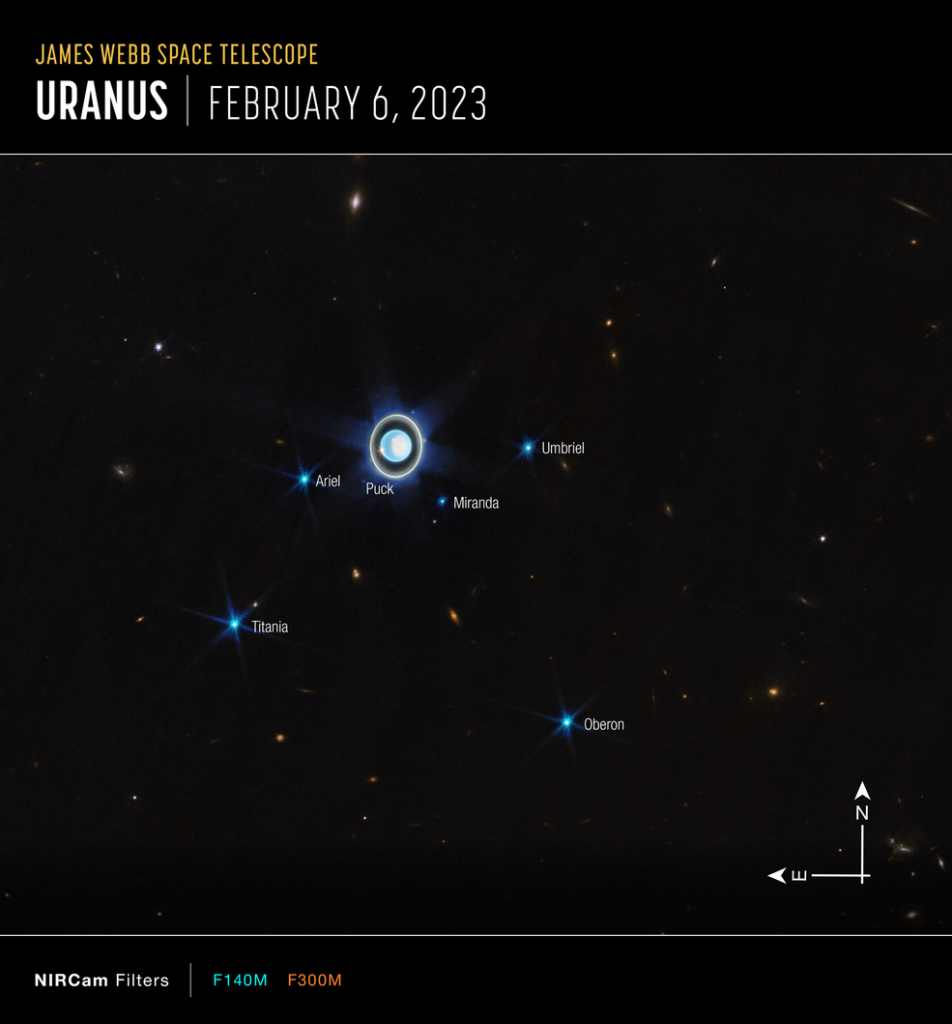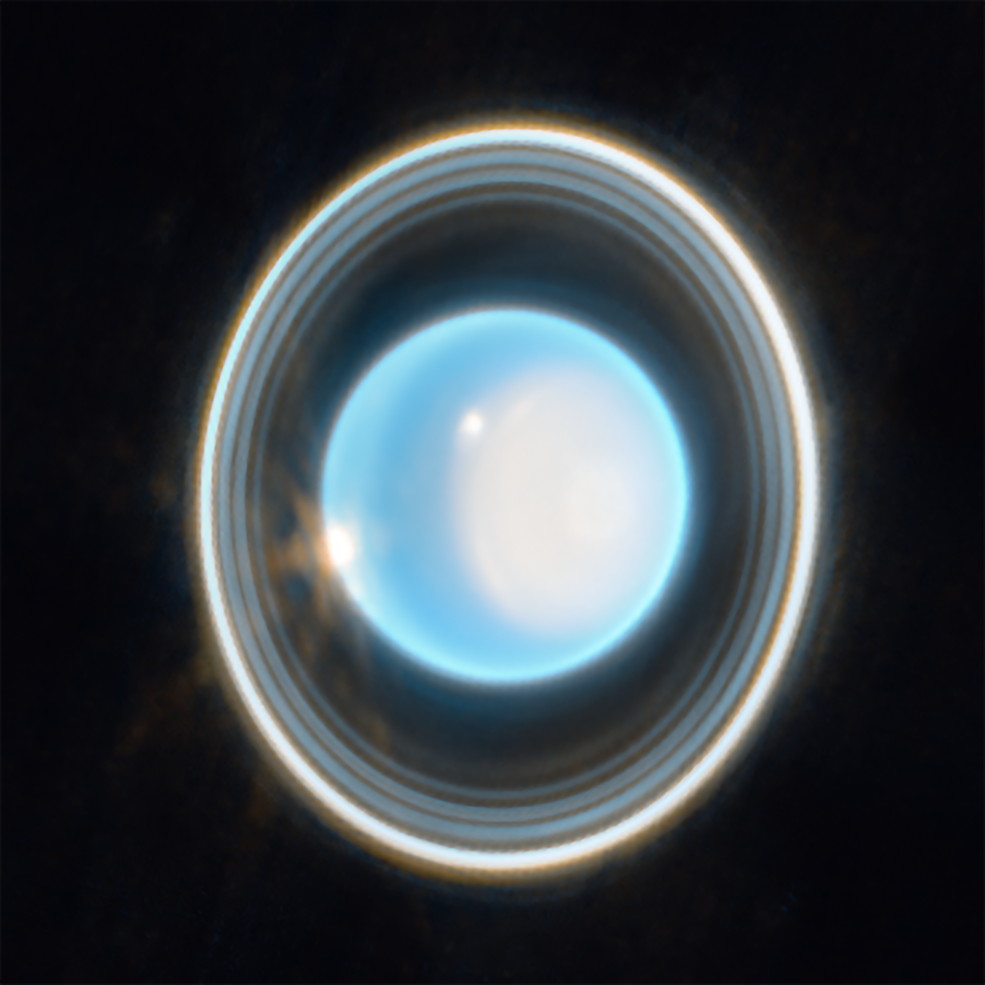|
Getting your Trinity Audio player ready...
|
NASA’s James Webb Space Telescope has captured a stunning image of Uranus, the seventh planet from the Sun, revealing details never seen before. The image, which features dramatic rings as well as bright features in the planet’s atmosphere, demonstrates the observatory’s unprecedented sensitivity for the faintest dusty rings, which have only ever been imaged by two other facilities: the Voyager 2 spacecraft as it flew past the planet in 1986 and the Keck Observatory with advanced adaptive optics.
Uranus is unique in the solar system as it rotates on its side, at roughly a 90-degree angle from the plane of its orbit, which causes extreme seasons. Uranus takes 84 years to orbit the Sun, and currently, it is late spring for the northern pole, which is visible in the new image. The planet’s northern summer will occur in 2028. In contrast, when Voyager 2 visited Uranus, it was summer at the south pole. The south pole is now on the ‘dark side’ of the planet, out of view and facing the darkness of space.
The image was captured by Webb’s Near-Infrared Camera (NIRCam), combining data from two filters at 1.4 and 3.0 microns, which are shown here in blue and orange, respectively. The planet displays a blue hue in the resulting representative-color image.
The image reveals a polar cap, which appears when the pole enters direct sunlight in the summer and vanishes in the fall. The sensitivity and longer wavelengths of Webb’s NIRCam may be why we can see this enhanced Uranus polar feature when it has not been seen as clearly with other powerful telescopes like the Hubble Space Telescope and Keck Observatory.

Credits: NASA, ESA, CSA, STScI. Image processing: J. DePasquale (STScI)
Uranus has 13 known rings, and Webb’s image shows 11 of them. Nine are classified as the main rings of the planet, and two are the fainter dusty rings that weren’t discovered until the 1986 flyby by Voyager 2. Scientists expect that future Webb images of Uranus will reveal the two faint outer rings that were discovered with Hubble during the 2007 ring-plane crossing.
Webb also captured many of Uranus’ 27 known moons, and the six brightest are identified in the wide-view image. This was only a short, 12-minute exposure image of Uranus with just two filters, and it is just the tip of the iceberg of what Webb can do when observing this mysterious planet.
The James Webb Space Telescope is the world’s premier space science observatory. Webb will solve mysteries in our solar system, look beyond to distant worlds around other stars, and probe the mysterious structures and origins of our universe and our place in it. Webb is an international program led by NASA with its partners, ESA (European Space Agency) and the Canadian Space Agency.
NASA
In 2022, the National Academies of Sciences, Engineering, and Medicine identified Uranus science as a priority in its 2023-2033 Planetary Science and Astrobiology decadal survey. Additional studies of Uranus are happening now, and more are planned in Webb’s first year of science operations.
The data from Webb’s observation of Uranus will provide valuable insights into the planet’s atmosphere, rings, and moons, helping scientists better understand this mysterious and unique planet. The image demonstrates the incredible capabilities of Webb, which has only just begun its mission and will continue to reveal new insights about our universe for years to come.
The image of Uranus captured by the James Webb Space Telescope has generated excitement among the scientific community. According to Heidi Hammel, a planetary astronomer at the Association of Universities for Research in Astronomy, the new image “reveals a dynamic and active world that is a stark contrast to the bland, uniform-appearing Uranus seen in visible light.”
The image provides new insights into the planet’s atmosphere and rings, revealing previously unknown features and phenomena. In particular, the image of the polar cap and the enhanced brightening at its center is a surprising discovery that will help scientists better understand the planet’s seasonal changes.
The James Webb Space Telescope is a joint project of NASA, the European Space Agency, and the Canadian Space Agency. It is the largest and most powerful space telescope ever built, with a primary mirror that is over six meters in diameter. The telescope was launched on December 25, 2021, and is currently in its commissioning phase.
The Webb telescope is expected to revolutionize our understanding of the universe, allowing scientists to observe the most distant and faint objects in the cosmos with unprecedented detail. The telescope’s advanced infrared capabilities will enable it to study the formation of galaxies, stars, and planets, as well as search for signs of life on other worlds.
The image of Uranus is just the first of many groundbreaking discoveries that the Webb telescope is expected to make in the coming years. With its unparalleled sensitivity and resolution, the telescope is poised to revolutionize our understanding of the universe and unlock some of its deepest mysteries.



